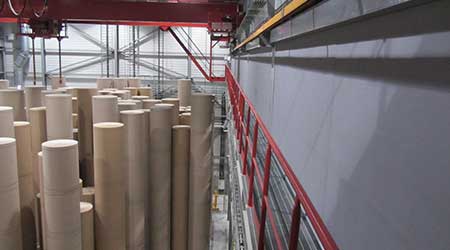« Back to Facilities Management Fire Safety/Protection Category Home
Fire- and Smoke-Protective Curtains: Understanding Fire Codes
March 2, 2018
- Fire Safety/Protection
By Steve Weyel
Fire- and smoke-protective curtains have become more commonplace at commercial buildings throughout the United States in the past decade. While curtains have been used extensively in Great Britain since the 1980s, most curtain use for commercial settings in the United States was limited to theaters. While the use of curtains evolves in commercial settings, some facility managers, construction officials, architects, and even fire department personnel have expressed frustration in knowing exactly which codes and standards apply. Recent updates have created even further confusion.
A report based on research by code expert Vickie Lovell and Douglas Evens, Fellow of the Society of Fire Protection Engineers, details codes and standards facility managers need to know about curtains. The report also includes applications that may be appropriate, and where they are inappropriate. Here are the highlights.
What Are Fire Curtains?
A fire- and smoke-protective curtain assembly is a flexible heat-resistant fabric infused with a coating to limit air infiltration. Curtains limit the effects of unimpeded migration of fire and/or smoke. They can be fixed in place, automatically deploy upon receiving a signal from a smoke protection device, or gravity-deploy on a loss of power. They can also be concealed above a ceiling and weighted to assist with deployment and limit deflection caused by air movement. They are not, however, an equivalent alternative to a fire-resistant floor or wall assembly.
Codes and Standards
There are several new and revised codes and test standards in the U.S. market to address the use of smoke- and fire-protective curtains. Underwriters Laboratories (UL) and the National Fire Protection Association (NFPA) have several codes that apply to these products. The most critical are UL 10D, UL 1874, and NFPA 80.
UL10 was approved in 2014 and evaluates fire-protective curtain assemblies intended to provide supplemental, passive fire protection as part of an engineered fire protection system. UL 1784, which was also recently introduced, tests assemblies for air leakage of door assemblies and other protectives. UL 864 addresses requirements for control units and accessories for fire alarm systems.
NFPA 80 regulates the installation and maintenance of assemblies and devices used to protect openings in walls, floors, and ceilings against the spread of fire within or into buildings. The 2016 edition of NFPA 80 added a new definition for fire-protective curtain assemblies. NFPA 80, Section 21.1.1, clarifies that the current generation of curtain assemblies are not to be confused with fabric fire safety curtains, which are specifically intended for protection of proscenium openings. Fabric fire safety curtain assemblies are part of the passive fire-resistive separation between the stage and the audience seating area. They are intended to provide at least 20 minutes of protection so audiences can safely evacuate. For recognition as proscenium opening protection, curtains must meet the requirements of the 2016 Edition of NFPA 80 Chapter 20, which deal specifically with fabric curtains.
Where to Use Them
Compliant applications for curtains include draft curtains for escalators, stair openings, and warehouse storage areas; smoke partitions, including opening protectives; elevator hoist-ways to limit smoke migration; non-egress opening protectives in corridors that require a 20-minute rating and smoke barriers; proscenium openings (provided the curtains also meet the requirements of Chapter 20 of 2016 NFPA 80); and service counter fire doors where 20-minute opening protectives are allowed. A UL Task Group is also considering the inclusion of horizontal sliding applications, which will create even more opportunities to use curtains.
Code compliance, performance, and aesthetic characteristics, integration with an engineered smoke control system, and available options should be considered when evaluating the use of smoke- and fire-protective curtain assemblies in commercial buildings. Options include firefighters' override, sizing, orientation, guide systems, fabric materials, and siren/strobe light capabilities.
Steve Weyel is a product manager with the BILCO Company, a manufacturer of specialty access products.








